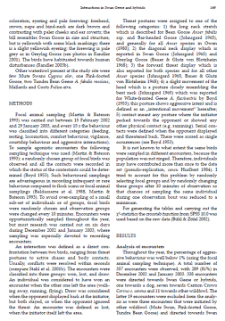- Search in all Repository
- Literature and maps
- Archeology
- Mills database
- Natural sciences
Advanced search
Advanced search
Advanced search
Advanced search
Advanced search

Object
Title: Song Structure and Repertoire Sharing in the Tawny Pipit Anthus campestris in Poland
Creator:
Osiejuk, Tomasz S ; Grzybek, Jerzy ; Tryjanowski, Piotr
Date issued/created:
Resource type:
Subtitle:
Song of Tawny Pipit ; Charakterystyka śpiewu świergotka polnego
Contributor:
Museum and Institute of Zoology, Polish Academy of Sciences
Publisher:
Museum and Institute of Zoology, Polish Academy of Sciences ; Natura Optima Dux Foundation
Place of publishing:
Description:
Type of object:
Abstract:
The present study characterizes the song of Tawny Pipit males (n = 55) recorded in May 2005 in the Wielkopolska region of Poland. Tawny Pipits sang with a very variable rate of 4–28 songs per minute (mean ± SE 16.0 ± 1.35). Songs were thus short, with an average duration of under 0.5 sec. At the same time, songs were relatively complex in structure and consisted of 2–3 (max. 5) units of frequency between 2.7 and 5.3 kHz. Based on visual inspection of sonograms and further cross-correlation analysis, 20 different song types were distinguished. Each male had only a single song type in his repertoire and the rendition of strophes produced by a male were very stereotypical. The songs of different males exhibited varying levels of similarity, from completely different, through sharing some within-song units, to strongly similar on sonograms. However, even the strongly similar songs of different males demonstrated some individuality in frequency parameters or fine note structure. On average, there were only 0.38 different song types per male within the population studied, and 83% of males sang song types shared with at least one other male. Nine of the 20 song types described were unique, i.e. sung by single males. The results of this study suggest that a highly variable song rate may be a signal of male motivation, whereas individual differences in song structure probably enable individual recognition.
Relation:
Volume:
Issue:
Start page:
End page:
Detailed Resource Type:
Format:
Resource Identifier:
oai:rcin.org.pl:55647 ; 10.3161/068.042.0210
Source:
MiIZ PAN, call no. P.257 ; MiIZ PAN, call no. P.4568 ; click here to follow the link
Language:
Language of abstract:
Rights:
Terms of use:
Copyright-protected material. May be used within the limits of statutory user freedoms
Digitizing institution:
Museum and Institute of Zoology of the Polish Academy of Sciences
Original in:
Library of the Museum and Institute of Zoology of the Polish Academy of Sciences
Access:
Object collections:
- Digital Repository of Scientific Institutes > Partners' collections > Museum and Institute of Zoology PAS > Scientific Journals
- Digital Repository of Scientific Institutes > Partners' collections > Museum and Institute of Zoology PAS > MIZ PAN Publications > Acta Ornithologica
- Digital Repository of Scientific Institutes > Literature > Journals/Articles
Last modified:
Oct 2, 2020
In our library since:
Jul 30, 2015
Number of object content downloads / hits:
34
All available object's versions:
https://rcin.org.pl./publication/75726
Show description in RDF format:
Show description in RDFa format:
Show description in OAI-PMH format:
Objects Similar
Osiejuk, Tomasz S.
Osiejuk, Tomasz S. Kuczyński, Lechosław
The composition and dynamics of a wintering bird community in an agricultural area of western Poland
Tryjanowski, Piotr
Olinkiewicz, Agata Osiejuk, Tomasz S.
Tryjanowski, Piotr Yosef, Reuven
Tryjanowski, Piotr Hromada, Martin (1969– ) Antczak, Marcin
Kuźniak, Stanisław (1933– ) Bednorz, Jan ( –2013) Tryjanowski, Piotr
Antczak, Marcin Hromada Martin Grzybek Jerzy Tryjanowski Piotr Polska Akademia Nauk. Muzeum i Instytut Zoologii

 INSTYTUT ARCHEOLOGII I ETNOLOGII POLSKIEJ AKADEMII NAUK
INSTYTUT ARCHEOLOGII I ETNOLOGII POLSKIEJ AKADEMII NAUK
 INSTYTUT BADAŃ LITERACKICH POLSKIEJ AKADEMII NAUK
INSTYTUT BADAŃ LITERACKICH POLSKIEJ AKADEMII NAUK
 INSTYTUT BADAWCZY LEŚNICTWA
INSTYTUT BADAWCZY LEŚNICTWA
 INSTYTUT BIOLOGII DOŚWIADCZALNEJ IM. MARCELEGO NENCKIEGO POLSKIEJ AKADEMII NAUK
INSTYTUT BIOLOGII DOŚWIADCZALNEJ IM. MARCELEGO NENCKIEGO POLSKIEJ AKADEMII NAUK
 INSTYTUT BIOLOGII SSAKÓW POLSKIEJ AKADEMII NAUK
INSTYTUT BIOLOGII SSAKÓW POLSKIEJ AKADEMII NAUK
 INSTYTUT CHEMII FIZYCZNEJ PAN
INSTYTUT CHEMII FIZYCZNEJ PAN
 INSTYTUT CHEMII ORGANICZNEJ PAN
INSTYTUT CHEMII ORGANICZNEJ PAN
 INSTYTUT FILOZOFII I SOCJOLOGII PAN
INSTYTUT FILOZOFII I SOCJOLOGII PAN
 INSTYTUT GEOGRAFII I PRZESTRZENNEGO ZAGOSPODAROWANIA PAN
INSTYTUT GEOGRAFII I PRZESTRZENNEGO ZAGOSPODAROWANIA PAN
 INSTYTUT HISTORII im. TADEUSZA MANTEUFFLA POLSKIEJ AKADEMII NAUK
INSTYTUT HISTORII im. TADEUSZA MANTEUFFLA POLSKIEJ AKADEMII NAUK
 INSTYTUT JĘZYKA POLSKIEGO POLSKIEJ AKADEMII NAUK
INSTYTUT JĘZYKA POLSKIEGO POLSKIEJ AKADEMII NAUK
 INSTYTUT MATEMATYCZNY PAN
INSTYTUT MATEMATYCZNY PAN
 INSTYTUT MEDYCYNY DOŚWIADCZALNEJ I KLINICZNEJ IM.MIROSŁAWA MOSSAKOWSKIEGO POLSKIEJ AKADEMII NAUK
INSTYTUT MEDYCYNY DOŚWIADCZALNEJ I KLINICZNEJ IM.MIROSŁAWA MOSSAKOWSKIEGO POLSKIEJ AKADEMII NAUK
 INSTYTUT PODSTAWOWYCH PROBLEMÓW TECHNIKI PAN
INSTYTUT PODSTAWOWYCH PROBLEMÓW TECHNIKI PAN
 INSTYTUT SLAWISTYKI PAN
INSTYTUT SLAWISTYKI PAN
 SIEĆ BADAWCZA ŁUKASIEWICZ - INSTYTUT TECHNOLOGII MATERIAŁÓW ELEKTRONICZNYCH
SIEĆ BADAWCZA ŁUKASIEWICZ - INSTYTUT TECHNOLOGII MATERIAŁÓW ELEKTRONICZNYCH
 MUZEUM I INSTYTUT ZOOLOGII POLSKIEJ AKADEMII NAUK
MUZEUM I INSTYTUT ZOOLOGII POLSKIEJ AKADEMII NAUK
 INSTYTUT BADAŃ SYSTEMOWYCH PAN
INSTYTUT BADAŃ SYSTEMOWYCH PAN
 INSTYTUT BOTANIKI IM. WŁADYSŁAWA SZAFERA POLSKIEJ AKADEMII NAUK
INSTYTUT BOTANIKI IM. WŁADYSŁAWA SZAFERA POLSKIEJ AKADEMII NAUK


































